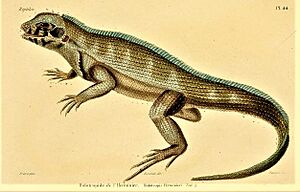Martinique curlytail lizard facts for kids
Quick facts for kids Martinique curlytail lizard |
|
|---|---|
 |
|
| Conservation status | |
| Scientific classification | |
| Genus: |
Leiocephalus
|
| Species: |
herminieri
|
| Synonyms | |
The Martinique curlytail lizard (Leiocephalus herminieri) was a type of lizard that is now extinct. It belonged to a group of lizards known as curly-tailed lizards. This species lived on the island of Martinique. Sadly, we don't know much about why it disappeared.
Contents
What's in a Name?
The second part of the lizard's scientific name, herminieri, honors a French naturalist named Félix Louis L'Herminier. Naturalists are scientists who study nature.
Where Can We See Them Now?
Today, there are only five known specimens of the Martinique curlytail lizard left. These are preserved lizards that scientists can study.
- Three specimens are kept at the National Museum of Natural History in Paris, France.
- One specimen is in the Natural History Museum in London, England.
- The last one is at the Naturalis Biodiversity Center in Leiden, Netherlands.
Where Did This Lizard Live?
Scientists believe the Martinique curlytail lizard lived on the island of Martinique. This island is in the Caribbean Sea. For a while, there was some confusion about exactly where the first specimens were found. Some early records also mentioned Trinidad and Tobago, but Martinique is now accepted as its home.
Why Did This Lizard Disappear?
Sadly, the Martinique curlytail lizard is now extinct. This means there are no more of these lizards alive today. We don't know much about how this lizard lived or exactly why it died out. We also don't know the exact date it became extinct. The last time scientists collected a specimen of this lizard was in the 1830s.
What Did This Lizard Look Like?
We can learn about the lizard's appearance from the preserved specimens.
- The largest female specimen found was about 139 mm (5.5 in) long from its snout to the base of its tail.
- The largest male was about 126 mm (5.0 in) long.
- Its head had large scales that were somewhat striped.
- The scales on its back were ridged and formed slanted rows.
- The scales on its sides and belly were also ridged.
- The lizard's back was a greenish-brown color. It sometimes had yellowish bands across it.
- Its head was yellowish with four or five black stripes on the sides.
- Its belly was yellowish.
- The lizard's throat had slanted black bands.


